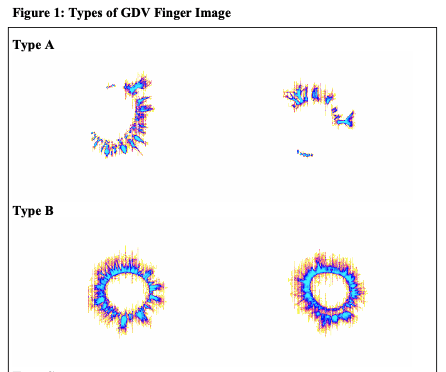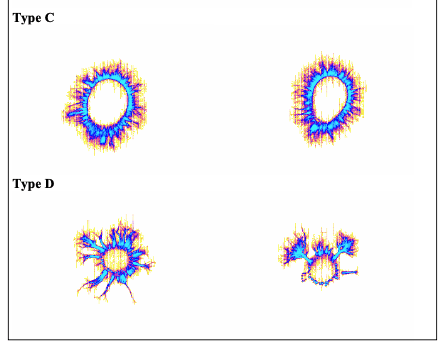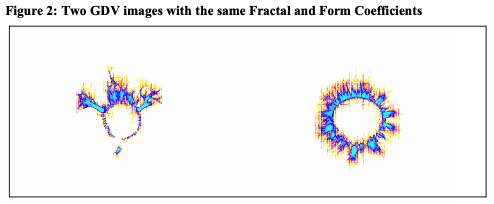RESEARCH REPORT
Investigations into Stress and it’s Management using the Gas Discharge Visualisation Technique
Dr. Paul Dobson and Elena Tchernychko MBA
City University Business School London, 1999

Introduction
The Gas Discharge Visualisation Technique (GDV) was developed by Konstantin Korotkov at St Petersburg State Technical University during the 1990s (see Korotkov 1998). In essence, a high intensity/tension/frequency electric field (3-20 kV, 1000Hz, for 10 microseconds) is created around an object which produces a gas discharge. As this discharge is accompanied by photon emission it can be photographed and analysed using appropriate computer software. In the basic technique there are therefore two outputs:
a) a photographic image
b) a set of parameters based upon the computer analysis of that image.
All objects, both animate and inanimate, when placed in a high tension electric field create a gas discharge the pattern of which is influenced by their properties. In the 1880’s, Nicola Tesla a Czech physicist working the US found that luminous discharges appear around the body when it is exposed to high frequency electromagnetic field. Since the 1940’s Kirlian photographs also produced by exposure to an electric field have revealed a human “aura”. The existence of the phenomenon is not in question, however, it’s explanation is.
One can discern three broad approaches to explanation, which are not mutually exclusive: the biological, the biophysical and the metaphysical.
The biological approach views the GDV image as a result of a temporary local reaction to an electric impulse, e.g. the ionisation of water molecules or salts on the skin, or a reaction to the iron in the blood. The gas discharge may also enable the photographic capture of the permanent but not normally visible thermal energy field around the fingers. Thermal imaging cameras reveal such a field quite clearly. Thus the change observed in an individuals image over time and the differences observed between individuals, are considered likely due to differences within and between people in the properties of their skin, body tissues and plasma. Such change can be linked to differences in finger metabolism which arise because of differences in organ functioning, diet, hormones, body rhythms, autonomic nervous system, or psycho-emotional states. Thus, the GDV image can be reasoned to have a biological basis which may reflect in a general manner both body functioning and mental states.
The biophysical approach uses our developing knowledge of body physics to provide an explanation. Thus, Korotkov argues that in addition to a thermal convection field that the human organism also has a complex electromagnetic field “which varies in response to the slightest changes in physiological condition”. The GDV image is influenced by this field because “under the high frequencies that are generated by sharp pulses the nature of the discharge is influenced by the properties not only of the local area of the skin by the electrode, but of the whole body as well” (p45). Thus a key distinction of the biophysical from biological approach, is that the images are not just the product of a local reaction but reflect the whole of the body’s energy field. “The physical aura of the biological object and man in particular is the total combination of the physical fields and radiations, formed by a body in space both due to its own emission and interaction with the processes in the environment” (p30).


The Western medical models of disease see threats to health and well-being as originating from outside the self. Illness is due to trauma, poisoning, or infection from some external toxic source. However, our capacity for homeostasis and immunological competence is affected not only by physical factors, but also by our level of emotional and mental well-being. From Eastern perspective our illnesses are often a reflection of our internal states of emotional unrest, spiritual blockage, and dis-ease.
Holistic Eastern models see the mind and body as part of the interconnected system. Thus, stress management techniques such as acupuncture, meditation, yoga, and tai-chi are reasoned to balance the human energy field by unblocking energy meridians. All of these techniques aim to achieve the integration of body, mind and soul. There is an assumption in the spiritual approach that a strong and complete body energy field represents a desirable healthy and harmonious state.
Korotkov uses the Su Jok system of acupuncture developed by Park (1993) to construct the body aura from parameter analysis of the finger images. “..the whole body of a person can be seen as projected onto one finger… consider the body as being organised on fractal principles… these ideas suggest that the energy system of the body displays holographic properties.. it is becoming recognised, that at some deep level, not only the body, but the whole universe has a fundamentally holographic structure. If this is true, … it means that the finger images can be a sufficient indication of the energy condition of the whole body” (p75). This reconstruction from the sectors of the image, represents the third output from the GDV, and is clearly dependent upon the validity of the Su Jok system.
Characteristics of the GDV Images and Parameters
Research questions:
a) For the same individual, are there significant differences in the images of different fingers at one point in time?
b) At one point in time, do different individuals display significantly different finger images? Can one individual be distinguished from another on the basis of their finger-prints? And if so,
c) Can GDV images be categorised in a reliable way? So that a number of judges acting independently would categorise the images similarly? What is the level of inter-judge agreement? To what extent do these categorisations differentiate between individuals?
d) To what extent does the categorisation of images remain stable over time? If the type of image changes, by the minute, hour, day or month can these changes be attributed to known effects? Or is the change apparently random?
The answers to these questions will indicate whether or not GDV images are potentially useful measures.
e) For the same individual, are there significant differences in the image parameters of different fingers at one point in time?
f) At one point in time, do different individuals display significantly different finger parameters? Can one individual be distinguished from another on the basis of their finger parameters?
g) To what extent do the parameters remain stable over time? If the parameter changes, by the minute, hour, day or month can these changes be attributed to known effects? Or is the change apparently random?
The answers to these questions will indicate whether or not GDV parameters are potentially useful measures.

Characteristics of the GDV Finger Images
Whilst the sample used is small, 11 people tested on two occasions giving 220 finger images, four types of image can be distinguished. There are clear differences between individuals in the nature of their finger images. These images appear to relate to
Korotov’s S, L, K+R, and N types. However, it is unnecessary to assume a Kirlian connection and for the present we will use a simple alphabet for classification: A, B, C & D types. The A, B & C types appear to reflect a continuum ranging from very fragmented weak images to complete rings. D images appear to be a qualitatively different type showing very distinctive lightning.
Full text PDF: Dobson_Investigations_into_Stress
